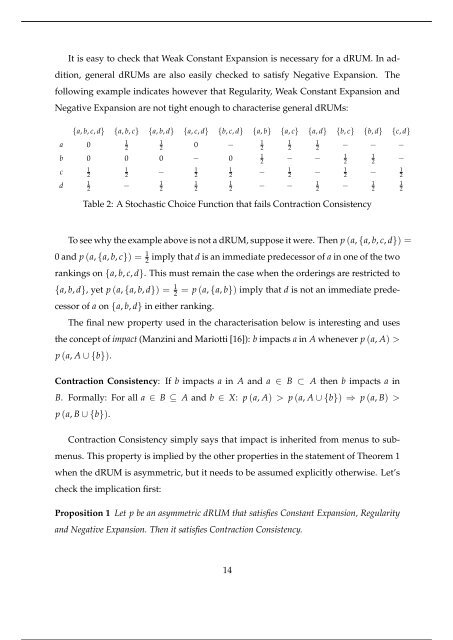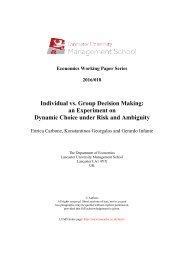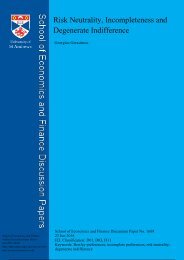Dual Random Utility Maximisation
n?u=RePEc:san:wpecon:1605&r=upt
n?u=RePEc:san:wpecon:1605&r=upt
Create successful ePaper yourself
Turn your PDF publications into a flip-book with our unique Google optimized e-Paper software.
It is easy to check that Weak Constant Expansion is necessary for a dRUM. In addition,<br />
general dRUMs are also easily checked to satisfy Negative Expansion. The<br />
following example indicates however that Regularity, Weak Constant Expansion and<br />
Negative Expansion are not tight enough to characterise general dRUMs:<br />
{a, b, c, d} {a, b, c} {a, b, d} {a, c, d} {b, c, d} {a, b} {a, c} {a, d} {b, c} {b, d} {c, d}<br />
a 0<br />
1<br />
2<br />
1<br />
2<br />
0 −<br />
1<br />
2<br />
1<br />
2<br />
1<br />
2<br />
− − −<br />
b 0 0 0 − 0<br />
1<br />
2<br />
− −<br />
1<br />
2<br />
1<br />
2<br />
−<br />
c<br />
1<br />
2<br />
1<br />
2<br />
−<br />
1<br />
2<br />
1<br />
2<br />
−<br />
1<br />
2<br />
−<br />
1<br />
2<br />
−<br />
1<br />
2<br />
d<br />
1<br />
2<br />
−<br />
1<br />
2<br />
1<br />
2<br />
1<br />
2<br />
− −<br />
1<br />
2<br />
−<br />
1<br />
2<br />
1<br />
2<br />
Table 2: A Stochastic Choice Function that fails Contraction Consistency<br />
To see why the example above is not a dRUM, suppose it were. Then p (a, {a, b, c, d}) =<br />
0 and p (a, {a, b, c}) =<br />
2 1 imply that d is an immediate predecessor of a in one of the two<br />
rankings on {a, b, c, d}. This must remain the case when the orderings are restricted to<br />
{a, b, d}, yet p (a, {a, b, d}) = 1 2<br />
= p (a, {a, b}) imply that d is not an immediate predecessor<br />
of a on {a, b, d} in either ranking.<br />
The final new property used in the characterisation below is interesting and uses<br />
the concept of impact (Manzini and Mariotti [16]): b impacts a in A whenever p (a, A) ><br />
p (a, A ∪ {b}).<br />
Contraction Consistency: If b impacts a in A and a ∈ B ⊂ A then b impacts a in<br />
B. Formally: For all a ∈ B ⊆ A and b ∈ X: p (a, A) > p (a, A ∪ {b}) ⇒ p (a, B) ><br />
p (a, B ∪ {b}).<br />
Contraction Consistency simply says that impact is inherited from menus to submenus.<br />
This property is implied by the other properties in the statement of Theorem 1<br />
when the dRUM is asymmetric, but it needs to be assumed explicitly otherwise. Let’s<br />
check the implication first:<br />
Proposition 1 Let p be an asymmetric dRUM that satisfies Constant Expansion, Regularity<br />
and Negative Expansion. Then it satisfies Contraction Consistency.<br />
14






